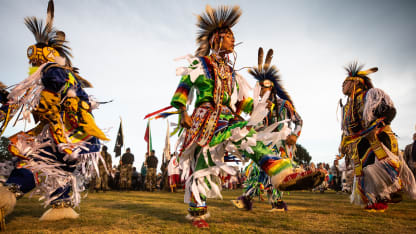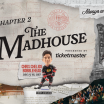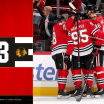Q: If someone were to ask you how to describe a Powwow, what would you say? What is a Powwow, generally?
HAMILTON: A Powwow is a traditional social gathering where dancers, singers and families come together to celebrate life through song and dance. The meaning of Powwow has changed from its beginning to now. Back in the 1800s, we had a war dance that the Omaha people would do after a battle; it was like a victory dance. They were very close with the Ponca Tribe, and when the Poncas were relocated to Indian Territory, which is presently Oklahoma, they brought that war dance with them, and they shared it with five different tribes in the northern part of the state. Since then, it has been shared with many, many tribes and has evolved into what we now refer to as a Powwow. Nowadays, almost all tribes participate in Powwows. In some cases, it's a homecoming for veterans and for families.
Our Sac & Fox Powwow this year is going to be huge because we haven't had our annual Powwow in two years due to the COVID-19 pandemic, so we have families and loved ones that are flying in from all over the country to be here, and that's exciting.
Q: Tell us a little bit about the Sac & Fox Powwow. It's the 57th annual, but what's the history, the significance of the Sac & Fox Powwow in particular?
HAMILTON: In the 1960s, some of our tribal members would have small gatherings on their property where they would dance and they would sing, and there was such a great interest that eventually more and more people got involved. Then, they finally started having a formal Powwow here on the reservation in Stroud and it's just grown since. Today, in the state of Oklahoma, the Sac & Fox Nation Powwow is considered one of the largest Powwows in the state.
Our Powwow is a homecoming for our people. We have families that fly in from California, Florida, Montana and beyond. All the locals, they come as well. It's a family reunion. The military veterans are home -- we honor the veterans quite often in any of our gatherings. And here at the Sac & Fox Powwow, we have family pavilions where families set up their campsite for the weekend and it's just a wonderful gathering of people from all over.
Q: How would you explain the event as a whole or the different components of it largely to someone who wants to learn? What is the typical structure of a Powwow?
HAMILTON: We have a Powwow committee that plans all year long for this event. The Powwow committee chooses what you call a 'Head Staff,' and the Head Staff are the people that actually run the Powwow. That consists of an emcee and an arena director, who is in charge of the arena and the schedule of the Powwow. Then we have a head singer, who is in charge of all the singers and the drum; a head man dancer, who leads all the men in all the social dances and the intertribal songs; and then we have a head lady dancer, who leads all the women. It's a great honor to be called upon to serve on Head Staff because there's so many people that could be chosen.
Thursday night is our traditional opening night, which is an evening of our Sac & Fox social dances. Grand Entry starts at 7 p.m. All of the dancers will line up on the east side of our arena, and when the song starts, the veterans will lead our grand entry. After the veterans, then it would be the head man dancer, the head lady dancer, and then all our royalty, not only from our tribe, but from other tribes. We honor the royalty, all the princesses and the braves, and then all the Golden Age, which are the elders, and then all the adults, teens and then juniors. They all come into the grand entry as a group and it's a beautiful sight to see.
Friday, Saturday and Sunday are a routine schedule. We have competition dancing in four different men's categories and four different women's categories and different age brackets. We have a variety of different styles, and you get to see different types of traditional dances. All these dances have creation stories and origin stories that date back many, many years. Some originated here in Oklahoma and some originated in different states with different tribes.
Q: Can the general public participate in a Powwow?
HAMILTON: Our Powwow, and most Powwows, are open to the public. We get a lot of folks from the public that come to see the beautiful regalias, see the dances, try the food because we have concession stands. They come to buy jewelry, we have arts and crafts people that set up their booth and they sell like bib work and ribbon work, shirts, shawls, necklaces…it's pretty awesome.
For the general public, as an announcer, it's our job to share the history behind each dance and to let the audience know what's taking place on the schedule. It's our job to describe the songs and the dances. The general public is invited to come and experience it all and learn about our culture. There may be some tribal members that want to invite you out to the arena to come dance with them, and you're welcome to come dance if you want. Of course, if you don't want to, then that's okay, too. But it's very educational for a lot of our non-Native American visitors.
Q: What is the significance of the traditional dances to the tribe, to the Sac & Fox people? How far back through the lineage do they go?
HAMILTON: A lot of our social dances date back to the time when our tribe lived in Saukenuk, Ill. Our people lived in present-day Rock Island, Ill. from around 1735 up to the Black Hawk War of 1832. A lot of these songs, a lot of these dances date back to that timeframe. So, a lot of these songs are very, very old. To be a singer, it's a big responsibility to remember these songs and to know why we sing them and when to sing them.
We have a Swan Dance that teaches us about the swans and how they used to be around the Great Lakes area. We have a Bean Dance that honors the gardening history of our tribe, and then the Shawnee Dance that was gifted to our people to unite everyone as one. And then there's the Pipe Dance that is a dance that's done by the men.
There is a different part of the program called the Gourd Dance, and that was a dance that most tribes use -- it originated with the Kiowa tribe, some say Comanche, and some say Cheyenne. They dance with their gourd, fan, sash and beads.
Q: What significance do the veterans play in Sac & Fox culture in particular and how does that play a role during the Powwow?
HAMILTON: As most Native American tribes do, they hold all the military veterans with high respect. We have veteran songs and military branch songs that we sing to honor those veterans. Sometimes, we'll have active-duty veterans that come home for the Powwow, and so we honor them during the Powwow. Also, during the Powwow we'll fly the flags to honor those deceased veterans that are no longer here. Every morning of the Powwow, we'll have the flag raising ceremonies and our drum group will sing songs, and then in the evening, before the sun goes down, they'll lower those flags.
A lot of these songs that we dance to are veteran songs, to honor them and their services. Some of those songs, the War Dance songs, date back to the 1800s. When our warriors would come home to the village from a battle or from a hunt, then they would sing those victory songs or those veterans' songs, and some of them we still use them today.


















